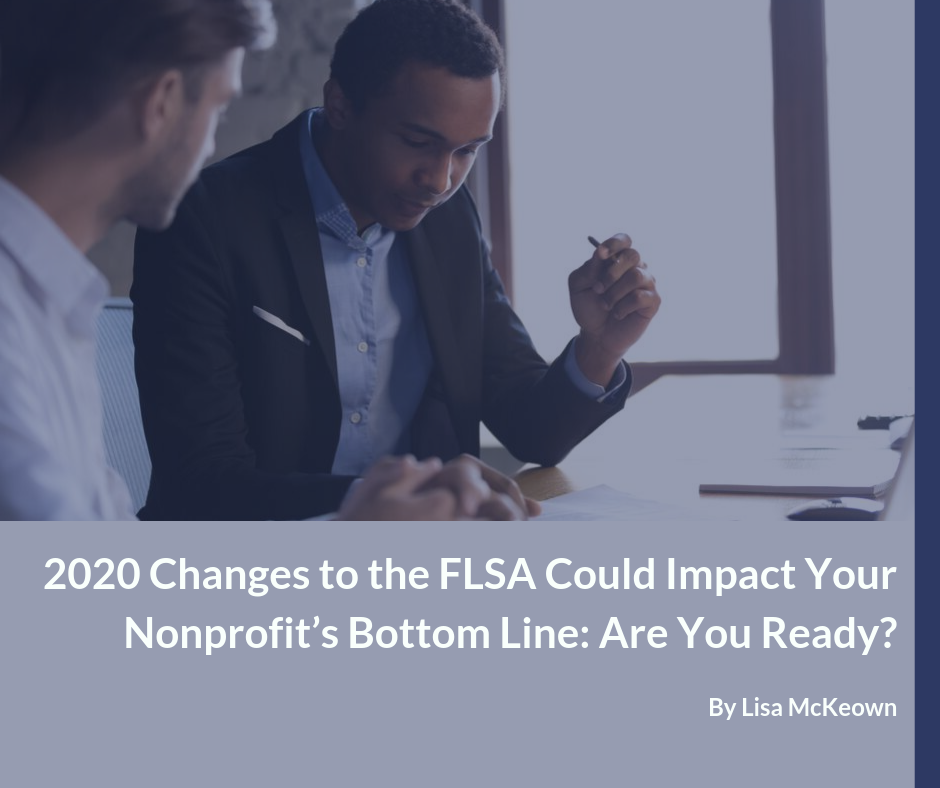WTOP: 5 ways nonprofits can…
Classification of exempt and nonexempt employees has always been one of the trickier areas of human resource compliance. Employees seem to feel a preference for being considered “exempt” and employers struggle with ensuring proper classification, although many prefer to avoid having to pay overtime and may improperly classify staff as exempt.
Last year the Department of Labor (DOL) announced a proposal to change the regulations of the Fair Labor Standards Act (FLSA) exemption tests. The DOL proposal would Increase the salary threshold for the executive, administrative, and professional exemptions and minimum total annual compensation level for the highly compensated employee exemption. Due to this change, many workers currently classified as exempt would be eligible for overtime pay due to their current salaries not meeting the new threshold. It has been estimated that nearly 5 million workers may be impacted by these changes. While this is currently a proposed rule, it is expected to be enacted by this summer and become law later in 2016.
The salary level for the current executive, administrative, and professional exemptions is $23,660 per year or $455 per week. The DOL has proposed to increase the threshold to $50,440, or $970 per week, but also intends to include automatic annual adjustments. The exemption for highly compensated employees would increase to the 90th percentile of annual wages of full-time salaries workers, increasing from $100,000 to $122,148.
Impact of the Change
The intent of the proposed regulation changes is certainly valid, in my opinion, and is aimed at protecting the overtime rights of workers while simplifying the rules for classifications. The current salary threshold has been in place since 2004, and is currently below the poverty level for a four-person family, so most recognize that this needs to be updated. However, the proposed new threshold represents a 113% increase over the current level, posing a sudden and major impact on employers. The proposed threshold is based on 40th percentile of average of U.S. full-time salaries (the current threshold represents approximately the 10th to 20th percentiles). The severity of this change will certainly impact many employers, particularly smaller nonprofits.
During the comment period for this rule, many employers expressed concern over the impact of this revised regulation. Many felt they needed time to prepare for such a change, and many have been lobbying to have their views heard on the issue. The final rule is expected this summer. Employers will be given a certain period of time, likely to be 60 days, to comply with the final rule once enacted.
The rule particularly poses challenges for small employers, nonprofits, and employers in lower cost-of-living areas. Small employers and some nonprofits have limited resources and typically pay lower salaries. They may be forced to layoff staff or limit work opportunities for staff if they are faced with increased payroll costs due to additional overtime pay. In many of these organizations. employees perform many roles and work remotely or after hours, including attending events or taking on projects to advance their careers. These opportunities would be limited if these employees were considered nonexempt as a result of their current salary level and forced to track their hours. Company productivity could decline. Even the executive director of some smaller nonprofits could fall below the salary threshold and become overtime-eligible. The new salary threshold does not take into account the differences in cost of living in various regions and the associated lower wages. A $50,440 salary in Iowa, for instance, is much different than that salary in New York City where the cost of living and wages are higher. For some nonprofits, benefits comprise a good portion of the total compensation package, and the value of benefits is not represented in the salary threshold.
The DOL is also considering changes to the duties test for overtime exemption. Currently, the test focuses on the primary duty of an employee’s job in order to meet the exemption, but they are considering a change that would require the employee to spend at least half of their work time performing the primary duty of their role. This would require employers to track how employees spend their time. It may require exempt employees to spend a specified amount of time performing their primary duty in order to remain exempt. Many smaller nonprofits have employees performing many roles in order to meet the organization’s mission. This may hinder nonprofits from having that flexibility and finding the resources they need.
There is a currently a push by some in Congress to get the FLSA changes enacted soon, to avoid any potential rejection by a new Congress or President in the fall. However legislation was recently introduced in both the House and Senate to delay the implementation of the proposed rule. The legislation requests that the DOL perform an economic analysis of the impact of the changes to nonprofits, small businesses and employers in other industry sectors. They are also requesting the elimination of automatic salary level increases and proper scrutiny of any changes to the duties test.
What Steps Can You Take To Prepare?
It seems inevitable that the FLSA exemption rules will change in some fashion, and the timeframe for the change is rapidly approaching. Nonprofits should be preparing now in order to reduce the impact, both from a financial and compliance perspective. Here’s how:
- Review salaries and classifications of current staff – Employers should take time now to review the FLSA classifications of their staff and determine who may be affected by the threshold change. You should calculate the financial impact if you were required to increase salaries of exempt employees to the new threshold in order to maintain the exemption versus what you might pay in overtime costs if these employees were reclassified as nonexempt. In the end, the goal is to properly classify employees to avoid liability and to ensure fairness to those employees who are legally entitled to overtime pay.
- Put systems in place to monitor work hours and the use of overtime – If you aren’t already, start tracking hours employees work, their tasks and how much of their time is spent on each, and how much overtime they tend to work. Tighten up processes for approval of overtime. Be clear about job expectations and scope.
- Consider flexible staffing options – In order to avoid overtime costs for those that will need to be classified as nonexempt due to not meeting the new salary threshold, think about using temporary, consulting, job-share, outsourced staffing for needs such as special projects or events.
I will hold out hope that the DOL will further review the impact of the regulation changes and prior to enactment, revise them to include a solution that works better for nonprofits and small businesses, and that recognizes the cost of living differences throughout the country. However, I realize we all need to do our best to strategize and prepare our organizations to deal with these changes so that we are not caught unprepared and in reactive rather than proactive mode. Organizations are liable for misclassifications under the FLSA and both employees and employers may suffer financial losses with the new regulations. Employees will also need to understand any changes the company undertakes in response to the new regulations so timely communication is essential.
On May 18, the Department of Labor issued their final ruling on changes in the Fair Labor Standards Act, raising the earnings threshold for overtime eligibility to $913 a week ($47,476 for a full-year worker). There are significant implications for all types of organizations, but particularly for nonprofits. Purchase a recording of a live webinar from Nonprofit HR, the nation’s leader in nonprofit human resources strategy, compensation and compliance, for an insightful look into the specific steps every nonprofit needs to take now.





























